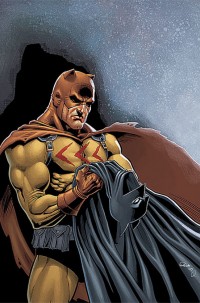SECRET SIX #9
What did the
iFanboy
community think?
Pulls
Size: pages
Price: 2.99
Secret Six number 9 is not a comic book; it’s a conversation, quite a lovely one in fact. Let me explain. Due to the power and stinging voice of fan culture, comics have evolved in the 21st century into a uniquely fantastic pop art form. Comic professionals and their readers are no longer separated by the typical walls that have that have always defined the relationship between the creator and admirer. Through interviews on ifanboy and wordballoon and a thousand other worthy locations, the admirers have gotten to know the ambitions, foibles, and ticks of these creators. By viewing real-time reactions to their work throughout media, these creators live in a world of instant feedback from their admirers on these same ambitions, foibles, and ticks. In admiring comics, the admirer brings this extra-textual knowledge of the creator; just as in creating comics, the creator acknowledges and responds to this extra-textual knowledge.
The end result of this odd, wonderful relationship between celebrity and celebrator is a creative product that neither exist on its own terms or just exists to be interpreted, but must be read in the context of not a theoretical but an actual give and take, or conversation, between the creator and the admirer. It’s as if comics plowed through the post-modern crisis of 1986 to emerge 20 years later with a new conception of how to read and write in this medium—call it supermodernism.
This issue of Secret Six exemplifies this new creative style and demonstrates the great pleasures that can be drawn its methods. Though she has a fun idea that could easily be played straight (bad guys doing good in Gotham to realize their hidden ambition to be Batman), throughout the issue, Simone is constantly acknowledging that these characters are in fact “characters” that exist in a fairly absurd comic universe full of silly men in silly tights saying silly things. Her tongue is so far in her cheek, it warps her voice into something truly transcendent. Ragdoll dressing up as golden age Robin and quoting the Batman TV show; Nightwing’s gratuitous male ass shot; Bane’s constant references to back breaking; Catman’s denial of being a Batman clone—and dozens of other examples are not here to support the story. These moments are meant to speak directly the reader, to say to us that she understands that we worship the history of these ridiculous, amazing characters, and she’s willing to play with that. In response, we post that we understood that she understood our understanding, and we loved it—and back and forth, and on and on, adding layers of complication and fun to what to outsiders may look like a fairly conventional and adolescent adventure. When we read Secret Six #9, we are not reading a comic; we are participating in a conversation on the history of comics and the potential and limitation of a genre and a medium.
All that, and, let’s face it, these guys are pretty bad ass. And how awesome is that? Right, Gail?
Art: 4 - Very Good




jesus christ, you just blow my mind!
that’s an interesting thoery but let’s not get ahead of ownselves.
Yes, podcasts and other media allow the reader with greater access to the creators today but i feel like you’re placing far too much importance on this idea. afterall, if the creator did simply react to the feedback of fans interested enough in her or his work to follow her/him though the net and gather some personal insight into her/him than the comic produced would be quite myopic in scope and potentially very bad.
I think instead, you have a specific affinity with Simone’s work, i.e., you just love the shit out of it, so you may have construct a reason for that.
however, you could be totally right and this is a new method of comic book production
Nice review.
it’s interesting, but the notion of inside jokes and self-referentiality isn’t THAT new. i think we’ve been there for some time, right? that said, your points about the conversation/community element are interesting…
In the second book of ‘Don Quixote’, our hero keeps running into people who read the first book of ‘Don Quixote.’ What I’m saying is, this has been going on for a while.
Interesting theory, though!